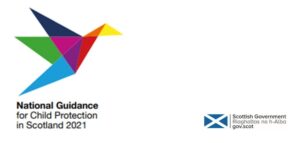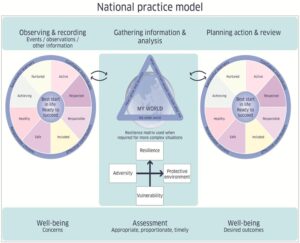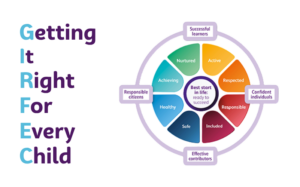Protecting Children in Scotland: A National Approach
Scotland’s commitment to safeguarding children and young people is centred around a series of coordinated national efforts.
From The National Practice Model to Getting It Right For Every Child (GIRFEC), and more recently, The Promise, each framework reflects Scotland’s commitment to providing child-centred care that gives children and young people the best possible foundations in life.
As a result, it is critical that providers understand the initiatives and how they can facilitate the consistent delivery of safe, high-quality care and transform outcomes.
The National Practice Model:
The National Practice Model is the main framework used within the Getting It Right For Every Child (GIRFEC) approach. This framework provides a consistent, structured, and holistic way for providers to assess, plan, and provide support for children and young people’s well-being, and is made up of 4 components, which we will discuss below.
The Well-Being Indicators (SHANNARRI):
There are 8 different indicators which providers and organisations should consider when working in collaboration with children, young people, and their families.
The indicators that must be considered in collaboration with children, young people, and their families are:
- Safe: Growing up in an environment where a child or young person feels secure, nurtured, listened to, and enabled to develop to their full potential, which includes freedom from abuse or neglect.
- Healthy: Having the highest attainable standards of physical and mental health, access to suitable healthcare, and support in learning to make healthy and safe choices.
- Achieving: Being supported and guided in learning and in the development of skills, confidence and self-esteem, at home, in school and in the community.
- Nurtured: Growing, developing and being cared for in an environment which provides the physical and emotional security, compassion and warmth necessary for healthy growth and to develop resilience and a positive identity.
- Active: Having opportunities to take part in activities such as play, recreation and sport, which contribute to healthy growth and development, at home, in school and in the community.
- Respected: Being involved in and having their voices heard in decisions that affect their life, with support where appropriate.
- Responsible: Having opportunities and encouragement to play active and responsible roles at home, in school and in the community, and where necessary, having appropriate guidance and supervision.
- Included: Having help to overcome inequalities and being accepted as part of their family, school and community.
When these 8 indicators are considered together, they provide a holistic view of each child or young person and consider their strengths and any obstacles they may face to grow and develop.
The My World Triangle:
This is the main tool used to gather information about the child or young person’s entire world and enables workers to measure their strengths and challenges in all areas of a child or young person’s life.
The triangle places the child or young person at the centre and measures how the individual needs to grow and develop, what they need from the people who look after them, and their experiences in the wider world.
The Resilience Matrix:
This matrix allows providers to assess how well a child or young person will be able to cope with the challenges throughout life and records information into 4 different areas: Resilience, Adversity, Vulnerability, and Protective environment.
The matrix collects information from various sources, and providers need to weigh up the good and the challenging things that a child or young person may face throughout their life. Once completed, the provider will then decide if a child’s plan needs to be developed.
Child’s Plan (GIRFEC) Guidance:
A non-statutory plan which should identify a range of extra support beyond universal provision to be planned, delivered, or coordinated. The plan should reflect the voice of the child or young person at every stage and clearly explain why the plan needed to be created, the personalised actions taken, and the expected improvements for the child or young person.The child’s plan should offer a simple planning, assessment and decision-making process which leads to the right help, at the right time.
It is essential that the plan be clear on what services or people will be providing support, who is responsible for the support and how the support will be provided.
Getting It Right For Every Child (GIRFEC):
GIRFEC is a commitment by the Scottish Government to ensure that all children, young people, and their families receive the right support at the right time, helping every child and young person in Scotland achieve their full potential. This approach promotes consistent and effective support for families and is rooted in a strengths-based framework. It aims to uphold children’s rights in everyday practice and is guided by core values and principles. Some of the key principles include:
- Placing a child or young person and their family at the centre, encouraging them to provide their input, with full participation in all decisions that affect them,
- Collaborating with families to enable a rights-respecting, strengths-based, inclusive approach,
- Understanding wellbeing as being about all areas of life, including family, community, and society,
- Valuing differences and ensuring everyone is treated equally,
- Considering, identifying, and addressing inequalities,
- Providing support for children, young people, and families when they need it until things improve, helping them reach their full potential, and
- Everyone working together in local areas and across Scotland to improve outcomes for children, young people, and their families.
This initiative provides Scotland with a consistent framework and shared language for promoting, supporting, and safeguarding the well-being of children and young people, and is embedded across Children’s Services Planning Partnerships with a focus on changing culture, systems and practice for the benefit of children, young people, and their families.
When a child’s well-being is flourishing and their rights are respected, they are better able to enjoy and defend these rights and are equipped with the support they need to address any challenges they may encounter in their lifetime.
The Promise:
Following an independent care review in 2020, the Scottish Government made a promise to the children and young people in Scotland that they would grow up loved, safe and respected so they can realise their full potential. This promise is underpinned by 5 key foundations which are at the heart of how Scotland thinks, plans, and prioritises children, young people, and their families.
The 5 key foundations underpinning “The Promise” are:
- Voice: Children must be listened to and meaningfully involved in decision-making involving their care, with all those involved properly listening and responding to what the children want and need. For The Promise to be effective, there must be a compassionate, caring, decision-making culture focused on children and whom they can trust.
- Family: When children are safe in their families and feel loved, they must stay, with families being provided support to nurture the love and overcome any difficulties that could potentially get in the way.
- Care: When living with the family is not possible, children must stay with their siblings, where safe to do so and belong to a loving home, staying there for as long as needed. When nurturing relationships within the family is impossible, those who care for the children must know that the most important thing they can do is to provide a loving, stable, safe relationship.
- People: Children should actively be supported to develop relationships with people in the workforce and the wider community, who in turn must be supported to listen to and be compassionate in their decision-making and care.
- Scaffolding: Children, families, and the workforce must be supported by a system that is there when it is needed. The core concepts of help, support, and accountability must be ready and responsive when and where it is required.
For social care professionals, they act as essential tools for consistent, accountable, and compassionate practice, and staying aligned with these national priorities ensures compliance and the best possible outcomes for the children you support.
Did you know that our Online Procedure Manuals for Children’s Services are now available in Scotland?
Our manual is unique as it supports practitioners in delivering a service that is consistent, child-centred, strength-based, and is underpinned by The National Practice Model, Getting It Right For Every Child (GIRFEC) and The Promise.
Want to learn more? Click here to book a demonstration or chat with one of the team.




